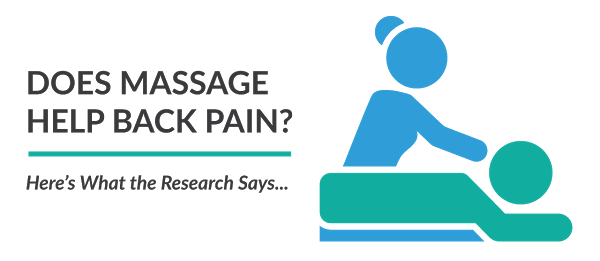Does Massage Help Back Pain? Here’s What the Research Says…
/If you have ever suffered from low back pain, then you know how uncomfortable it can be. Simple everyday things such as tying your shoes, sitting in a chair, sleeping in bed, and walking upstairs can become big challenges. Daily discomfort is no fun.
Approximately 80 percent of adults experience back pain at some point in their lives. Older individuals that are overweight are at a greater risk for developing back pain. It’s not just something that impacts athletes or people that do physical labor. In fact, 54 percent of Americans who have low back pain spend the majority of their workday sitting. Sedentary lifestyles can initiate chronic back pain.
In addition to physical pain, back problems carry serious economic consequences. Low back pain is the second most common cause of disability in adults in the U.S., and the leading cause of missed work days. Americans spend approximately $50 billion each year in medical expenses related to back issues.
Difficulties in massage research
Fortunately, there are a variety of treatment options available for back pain. Conventional treatments include hot packs, stretching and strengthening exercises, physical therapy, acupuncture, traction, epidural steroid injections, medications, spinal manipulation, nerve block therapy, and surgery. One remedy that is becoming more widely accepted by the medical community is massage therapy.
Back massages are relaxing and feel good. But do they help back pain?
Research on the health effects of massage therapy faces several challenges. First, there is a lack of funding for large research studies. Without money, studies cannot get off the ground. Additionally, it’s difficult to administer double-blind, placebo controlled tests. Unlike a placebo pill that looks the same as a real pill, people know when they have received a back massage. This means research relies primarily on patient surveys and feedback. The more people read and hear in the news about massage therapy, the more likely they are to report biased results.
Although massage therapy research is difficult to execute, that doesn’t mean it doesn’t serve a purpose and can’t contribute to a body of scientific knowledge. Here is what the current research says about the impact of massage therapy on back pain.
Overview of the research
A study published in Pain Medicine by researchers from the University of Kentucky and Indiana University suggests that massage can help individuals with lower back pain. The study looked at 104 individuals with persistent pain. Each person was referred to a professional massage therapist and provided with 10 massage sessions over a 12 week period. More than 50 percent of the participants reported improvement. Of those, 75 percent noted that they still felt better after 24 weeks.
A 2011 study published in Annals of Internal Medicine concluded that massage may be effective for treating chronic back pain, with benefits lasting at least 6 months. Researchers examined 401 people that reported chronic back pain. Individuals were divided into three treatment groups: relaxation massage, structural massage, and regular physical therapy and pain medication. Patients in the massage groups received one hour of weekly therapy for 10 weeks. Both massage treatments had significantly greater effects than usual physical therapy. There was no clinical difference between the two types of massage.
A single-blind study published in 2016 in Complementary Therapies in Medicine examined the immediate effect of thai massage in patients with upper back pain. Each participant had to report having upper back pain for at least three months before the study. Researchers assigned 50 individuals to one of two groups, a 30-minute session of Thai Massage or control. Those in the control group received sham microwave diatheramy, which essentially consisted of a micro-wave therapy machine that was turned on next to participants but was not used. Individuals in the Thai Massage group reported significantly greater reduction in muscle tension and upper back pain compared to those in the control group.
A meta analysis study in 2015 examined 25 research trials. Researchers concluded that there is strong evidence to suggest that massage is an effective treatment for low back pain in the short term. However, they did not have enough evidence that showed significant patient improvements in long-term follow ups.
Massage Research Going Forward
Ultimately, more research is needed to confirm the effect of different massage types on back pain over the long term. This can help bridge the gap between research and clinical practice by massage therapists. There are many different massage techniques, such as Swedish Massage, Shiatsu, Thai Massage, Deep Tissue, and Reflexology among others. Some massage styles may have more of an impact on back pain than others. However, there is no denying the findings so far are encouraging.
Massage is a less intrusive treatment option that carries little risk for the patient. At the very least it is something physicians and physical therapists should consider strongly before recommending surgery, which should only be used after other therapies have failed. Also, there are many potential benefits to massage beyond back pain reduction. As more research is conducted, we’ll have a better understanding of how massage fits into a more holistic approach to healthcare, and how it can be applied to help different patients.
About The Author
Robert Ellis is an e-commerce entrepreneur and the Owner of Massage Tables Now, an online provider of equipment and supplies for massage therapists.




